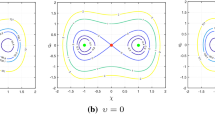Abstract
Calculation of electromechanical transients and the stability of large, complex electric-power systems, even given a significant computing capacity, is a computationally complex problem, the solution of which is time-consuming, and, in some cases, for a large-scale system, this problem is unsolvable. This paper presents an approach to developing the equivalent of a global energy network for calculating transient stability. The dynamic equivalent of a large-scale electric-power system obtained using the method of coherent-group-generator reduction and network reduction, can significantly reduce the scale of the problem under consideration and obtain a solution using well-known software and computing systems. The creation of a dynamic equivalent of a global-energy-network is a daunting task, which requires data on all the power systems composing the energy network, which it is also a difficult task to collect. For a qualitative assessment of the power-network stability, the parameters of the dynamic equivalents can be calculated from the generalized indicators of power systems.



Similar content being viewed by others
REFERENCES
Main parameters of calculation models of power electrical system in March 2020. https://www.so-ups.ru/fileadmin/files/company/reports/disclosure/ 2020/model_ups_0420.pdf
Yang, Y. and Zha, X., Time domain aggregation of generating units for shipboard power systems, Trans. China Electrotech. Soc., 2019, vol. 25, no. 4.
Zin, A.A.M., Kok, B.C., Mustafa, M.W., Lo, K.L., and Ariffin, A.E., Time domain dynamic aggregation of generating unit based on structure preserving approach, Proc. Nat. Power Engineering Conf., 2003. PECon 2003, Bangi, Malaysia, 2003, IEEE, 2003, pp. 154–160. https://doi.org/10.1109/PECON.2003.1437436
Edlin, M.A., Formation of external equivalents for mathematical models of power systems, Izv. NTTs Edinoi Energeticheskoi Sist., no. 2, pp. 82–87.
Schematic map of placement of electric transmission lines, substations with a voltage of 220 kV and above in the Crimea Republic and Sevastopol in 2020–2026. https://energybase.ru/map/map-substations-powerplants-crimea-sevastopol.
Schematic map of placement of electric transmission lines, substations with a voltage of 220 kV and above of the Unified Electric System of the South in 2020–2026. https://energybase.ru/map/map-substations-powerplants-south.
Barinov, V.A. and Lisitsyn, N.V., Directions of development of Russian electric power industry. Integration of the Unified National All-Russian Power Grid to the global electric power grid, Vesti v Elektroenerg., 2017, no. 1.
Structure of power generation of electric power systems of the countries across the world. https://peretok.ru/articles/generation/
Values of nominal powers of electric power stations of electric power systems of the countries across the world. https://www.eeseaec.org/ustanovlennaa-mosnost-elektrostancij
Ryzhov, Yu.P., Dal’nie elektroperedachi sverkhvysokogo napryazheniya (Ultrahigh-Voltage Long-Distance Power Transmission Lines), Moscow: Izdatel’skii Dom Mosk. Energ. Inst., 2007.
Funding
This work was carried out within the framework of the project “Development of Methods for Managing the Sustainability of the Global Energy Conglomeration” project with the support of a grant from Moscow Power Engineering Institute for the scientific research programs “Energy, Electronics, Radioengineering, and IT” and “Industry 4.0 Technologies for Industry and Robotics in 2020—2022.”
Author information
Authors and Affiliations
Corresponding author
Additional information
Translated by A. Kolemesin
About this article
Cite this article
Kuznetsov, O.N., Zubkova, I.S. & Averyanov, D.A. A Global-Energy-Network Equivalent for Calculation of Transient Stability. Russ. Electr. Engin. 93, 46–52 (2022). https://doi.org/10.3103/S1068371222010047
Received:
Revised:
Accepted:
Published:
Issue Date:
DOI: https://doi.org/10.3103/S1068371222010047




